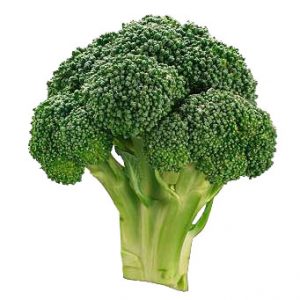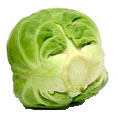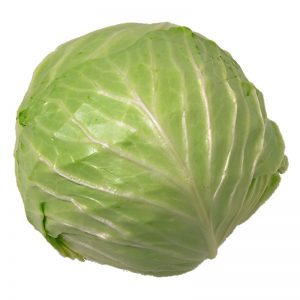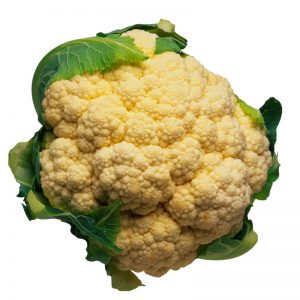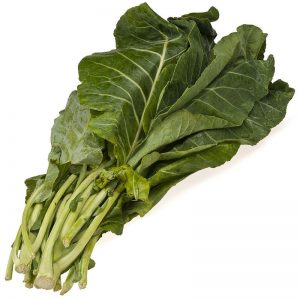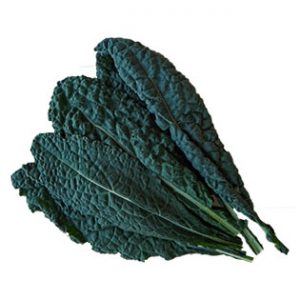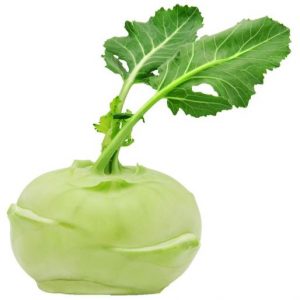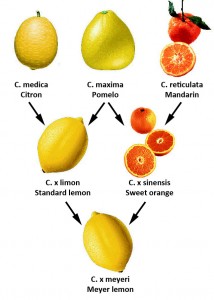Fun facts
Avocados
What is the purpose of fruit?
The purpose of most fruit is to be eaten by an animal who, at a later time and hopefully elsewhere, excretes the seeds that were contained within the fruit and thus helps the plant to disperse.
What animal could possibly excrete an avocado seed (aka pit)?
Avocado trees are native to Central America. The largest frugivores in Central America are tapirs. According to a 2013 paper entitled Frugivory and seed dispersal by tapirs, the maximum size of seed that a tapir can excrete is around 2cm in diameter. Avocado pits are typically 5cm or more in diameter. So, the answer is not tapirs!
According to a 2009 paper entitled Using dung bolus diameter for age estimation in an unstudied elephant population in Udzungwa Mountains, Tanzania, elephant dung can be up to 18cm in diameter and so elephants could presumably excrete an avocado pit. But there are no elephants in Central America, and never have been. So, the answer is not elephants!
 Rather, the answer is apparently megafauna which have now gone extinct, such as giant ground sloths (genus Megatherium).
Rather, the answer is apparently megafauna which have now gone extinct, such as giant ground sloths (genus Megatherium).
Given the demise of the megafauna, how do avocado trees disperse nowadays?
Without human assistance, they can’t. In other words, the avocado is ‘an evolutionary anachronism’ which is no longer able to manage its seed dispersal.
How can I find out more?
Read the discussion on the Smithsonian website.
Or if, like Donald Trump, you prefer to get your information by watching rather than by reading, watch and listen to a video of someone called Connie Barlow singing a song entitled Ghosts of Evolution (which is actually worth watching).
Bonus factoid: in researching this little article, I happened to find out that one of the most expensive coffees in the world is made from coffee beans that have been consumed and then excreted by elephants – see Wikipedia. You can buy this coffee online.
Bananas
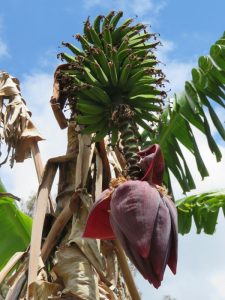 If you have a banana plant, and you protected it from the frost, then it might well now be bearing bananas. But these bananas won’t have been pollinated. How come?
If you have a banana plant, and you protected it from the frost, then it might well now be bearing bananas. But these bananas won’t have been pollinated. How come?
What is the purpose of a fruit?
The purpose of most fruit is to be eaten by an animal who, at a later time and hopefully elsewhere, excretes the seeds that were contained within the fruit and thus helps the plant to disperse.
Bananas are seedless, so what is the purpose of a banana?
A banana has no purpose. Banana plants, like mules, are sterile.
So, why do bananas exist?
Bananas exist only because humans like eating them. X thousand years ago, a mutant banana plant whose bananas were seedless serendipitously happened to come into existence. A human happened to eat its bananas and thought “yum”. This human happened to be an ur-agriculturalist and he/she happened to take suckers from the plant and grow them. Their progeny or equivalent happened to do the same thing, and so on, thus replacing natural dispersal mechanisms via seed with artificial dispersal mechanisms via sucker.
Where does pollination fit in?
Pollination doesn’t fit in. Because bananas are seedless then, by definition, they are not pollinated.
So, what is the purpose of the male flowers on banana plants?
Male banana flowers have no purpose. They are, like emu wings, just a hangover from history.
How does the banana grow if it is not pollinated?
It is true that fruit usually only grow if the seeds that they contain have been pollinated. But this is because natural selection acts against it (it has costs but no benefits) rather than because there is a biological law which prevents it. After all, it is never the fruit itself that is being pollinated. There will have been many mutant banana plants which had undeveloped seedless bananas, but no ur-agriculturalist ever said “yum” and propagated them, so they no longer exist.
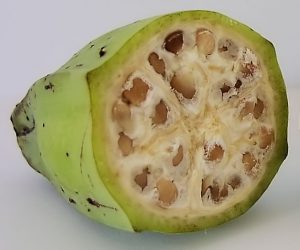 Nerdy aside: when the fruits develop without any pollination, this is called parthenocarpy. As well as bananas, it happens with some figs, pineapples and other plants.
Nerdy aside: when the fruits develop without any pollination, this is called parthenocarpy. As well as bananas, it happens with some figs, pineapples and other plants.
Yosefine Deans has written in to point out that, whilst commercial bananas are seedless, wild bananas have seeds and these have to be pollinated by bats or other animals for the fruit to set. See, for example, this article on the Bat Conservation International website. (the picture right is from Wikipedia)
Whilst we’re on the subject, here’s another fun fact: once a banana plant has fruited, it will never fruit again. So you should cut it down to make room for the other suckers. Has anyone got a machete that I could use?
Brazil nuts
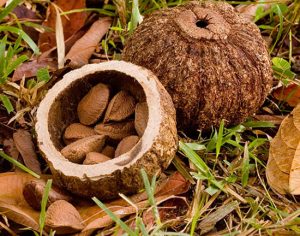 The flower of a brazil nut tree can only be pollinated by an insect strong enough to lift the coiled hood and with tongues long enough to negotiate the complex coiled flower. In practice, this means the female long-tongued orchid bee.
The flower of a brazil nut tree can only be pollinated by an insect strong enough to lift the coiled hood and with tongues long enough to negotiate the complex coiled flower. In practice, this means the female long-tongued orchid bee.
Bees only exist where they can mate. So, the smaller male bees are also required. But they are only attracted by a certain type of orchid. So, the tree needs to be in the presence of that orchid.
The tree’s fruit is actually the size of a coconut and the brazil nuts are seeds rather than nuts (8-24 within a single fruit). So, the fruit needs to be cracked open and this requires a large rodent (i.e. an agouti).
So propagation of brazil nuts requires agoutis, orchids and strong, long-tongued bees.
Cabbage
Why is Romanesco broccoli sometimes called Romanesco cauliflower (and vice versa)?
At one level, it is because some people think it tastes quite like broccoli whilst other people think it tastes quite like cauliflower. But, at a deeper level, it is because Romanesco can interbreed with both broccoli and cauliflower, producing fertile offspring, and thus it is the same species as both of them. (A ‘species’ being defined as the largest group of organisms in which the individuals can mate and can produce fertile offspring.)
But doesn’t that mean that broccoli and cauliflower are the same species?
Yes, Brassica oleracea.
As we are talking about broccoli and cauliflower, why does this discussion have the heading ‘cabbage’?
Because cabbage is also the same species(!), and the original wild plant from which they are all derived is called ‘wild cabbage’.
Does Brassica oleracea have any other vegetable forms?
Yes, Brussels sprouts, collard greens, kale and kohlrabi.
But some of these vegetables look completely different from each other!
That’s partly a matter of our perception because we eat different parts of the different vegetables. For kale and collard greens, we eat the leaves; for cabbage and Brussels sprouts, the leaf buds; for broccoli and cauliflower, the flower buds; and for kohlrabi, the stems. The parts that we don’t eat, and which therefore haven’t been manipulated by us over time, such as the flowers, look very similar.
How did all these vegetables come into existence?
Artificial selection by humans.
When did the all come into existence?
No one really knows because it was so long ago. According to Wikipedia, kale came first (5th century BC), then cabbage and kohlrabi (1st century AD), then cauliflower (15th century AD), then broccoli (16th century AD), and then Brussels sprouts (18th century AD).
This proliferation of types of Brassica oleracea still goes on. For example, ‘broccolini’ was created in 1993 by a Japanese seed company.
Carrots (orange)
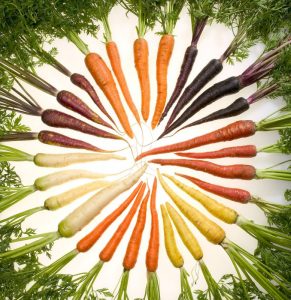 Three facts appear to be clear. First, wild carrots were historically purple, yellow or white. Second, modern orange carrots emerged in the Netherlands in the 17th Century and are orange because of their abundance of carotenes. Third, the Netherlands in the 17th Century (and later) was ruled by the House of Orange. What is less clear is the linkage or otherwise between these three facts. Popular anecdote is that orange carrots were purposively developed as a tribute to William of Orange but Wikipedia says: “there is little evidence for this“.
Three facts appear to be clear. First, wild carrots were historically purple, yellow or white. Second, modern orange carrots emerged in the Netherlands in the 17th Century and are orange because of their abundance of carotenes. Third, the Netherlands in the 17th Century (and later) was ruled by the House of Orange. What is less clear is the linkage or otherwise between these three facts. Popular anecdote is that orange carrots were purposively developed as a tribute to William of Orange but Wikipedia says: “there is little evidence for this“.
In researching this subject, here are a few other interesting ‘factoids’ that I found out. First, the colour is named after the fruit, rather than the other way round (before the fruit became known in England, the colour was apparently called either geoluread or geolucrog in English). Second, the House of Orange adopted the colour orange simply because the city in France from whence they came happened to have the same name as the colour. Lastly, although the House of Orange has ‘ruled’ the Netherlands for hundreds of years, the Dutch flag contains no orange (it is red, white and blue), anecdotally because the orange dye in the original flags was unstable and turned to red in the period from when they were first made until the time that the colours of the flag were officially 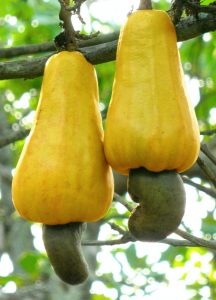 decided.
decided.
Cashew nuts
What appears to be the fruit (called a cashew apple) of a cashew tree is not actually the botanical fruit (it is the swollen stem) and does not contain the cashew nut. Whilst it is edible (and tasty), it does not travel well because the skin is so fragile.
The true fruit grows at the end of the cashew apple and contains a single cashew nut (which is actually a seed rather than a nut).
Whilst the cashew apple is not a fruit, it does serve the same purpose, namely to attract the birds and fruit bats who then spread the cashew nuts around.
Are there any other trees where the nut is not inside what we think of as the 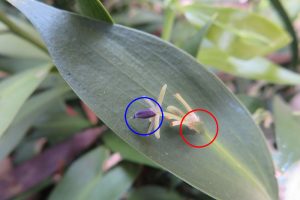 fruit?
fruit?
Another plant with a swollen stem is spineless butcher’s-broom (Ruscus hypoglossum). What looks like the leaf is actually a swollen stem, and the actual leaf (highlighted by the red circle in the picture far right) plus flower (highlighted by the blue circle) are both part of the bug-like thing in the middle of the stem.
Chillis
Why do chillies taste hot?
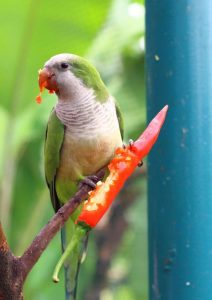 Chillies taste hot to us because they contain a chemical called capsaicin. Capsaicin binds with pain receptors in our mouth and throat, giving us the sensations of heat and, sometimes, pain. It may be produced by the chillies as a defence against mammalian predators who (apart from humans) don’t like the sensations.
Chillies taste hot to us because they contain a chemical called capsaicin. Capsaicin binds with pain receptors in our mouth and throat, giving us the sensations of heat and, sometimes, pain. It may be produced by the chillies as a defence against mammalian predators who (apart from humans) don’t like the sensations.
But, as fruit, don’t chillies ‘want’ to be eaten so that their seeds can get dispersed?
Yes, but not by mammals – chilli seeds are not sufficiently robust to survive passing through mammal guts. But they can usually pass through bird guts unharmed. So chillies ‘want’ to be eaten by birds. And, ‘luckily’, the pain receptors in birds do not detect capsaicin so chillies don’t taste hot to them.
Anything else I should know?
Yes, lots.
What an animal can taste depends on what taste buds it has. Whilst humans (and dogs) can taste ‘sweet’, cats (and dolphins) cannot. Mammals have many more taste buds than birds and, for example, I have around 300 times as many taste buds as my chickens (10,000 compared with 30). Cows (and other herbivores) have the most taste buds because they need to be able to tell if a specific plant contains dangerous toxins.
Flies (and octopuses) mainly taste with their legs.
At least as a spice, chilli is often associated with India. But this didn’t used to be the case: chilli is native to Central and South America and only found its way to India at the end of the 15th Century, following Christopher Columbus’s visits to Central and South America. Before that, Indian cuisine used black pepper to give pungency and the word for chilli in different Indian languages is basically a variation of the word for pepper (e.g. in Hindi, kali mirch for black pepper and hari mirch for chili).
Chilli and capsicum are the same species (Capsicum annuum). The only genetic difference between them is a recessive gene in capsicums that eliminates capsaicin and thus the hot taste.
Whilst chilli plants are technically perennial, they only live for a few years and, in Melbourne, are often killed off by the cold during winter. An easier-to-grow alternative is the rocoto tree chilli (Capsicum pubescens): it has a much longer life, survives the Melbourne winters, and produces fruit for much of the year. Also, it can effectively be eaten as either capsicums (when green) or chillies (when red).
Figs
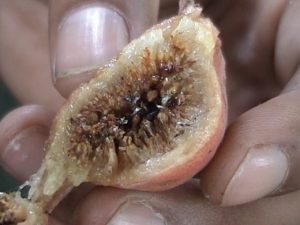 What do you think a fig flower looks like? The answer is that you probably don’t know even though you have probably both seen them and eaten them. How come?
What do you think a fig flower looks like? The answer is that you probably don’t know even though you have probably both seen them and eaten them. How come?
The flowers of a fig tree are actually inside the figs. Indeed, all that squishiness inside of a fig is basically flowers. So, a fig is not a fruit; rather, it is something called a syconium (“an enlarged, fleshy, hollow receptacle with multiple ovaries on the inside surface”).
So, if the flowers of a fig are inaccessible to normal pollinators, such as bees, how do they get pollinated?
If you look closely at a fig, you will see a small hole in the bottom of it. Tiny wasps (called fig wasps) crawl in through those holes and do the pollination.
What happens to the wasps after they have done the pollination?
They die in situ.
And what happens to the bodies of the dead wasps?
You eat them when you eat a fig. All the black dots in the picture are dead fig wasps.
For more information, watch this video.
Yuk!
Luckily for the squeamish, some varieties of fig do not require pollination. And most of the figs bought in shops will be from these varieties. But, at least according to Louis Glowinski in this book The Complete Book of Fruit Growing in Australia, the best tasting figs are from those varieties which do require pollination.
Nerdy aside: it is only the female fig wasps that do the pollination. The wingless male fig wasps are borne, impregnate their sisters, drill little holes in the skin of the fig for their sisters to escape by, and then die. The winged female fig wasps are borne, get impregnated by their brothers, get covered in pollen as they leave through the holes created by their brothers, enter another fig through its base, lay their eggs, and then die. So, whilst a male fig wasp only sees one fig in its life, a female fig wasp sees two.
Why is there a ‘d’ in fridge but not in refrigerator?
Fridge is a shortened form of the word refrigerator. Let’s say that you were trying to shorten the word refrigerator, how would you spell that shortened form? Maybe frig. But that would be a problem because all words in the English language which end with the letter ‘g’ are pronounced with a hard-g (e.g. pig), whereas the ‘g’ in refrigerator is soft. So, maybe frige. But that would be a problem because apparently all words in the English language which end with the letters ‘ge’ are pronounced with the previous vowel being long (e.g. huge), whereas the ‘i’ in refrigerator is short (i.e. as in kit rather than kite). So, to turn the ‘i’ from long to short, a ‘d’ is inserted before the ‘g’ (as in bridge).
Note that if the word was spelt phonetically (i.e. as it is pronounced), the shortened form would actually be spelt frij.
If you to want to wrap your head round another example of this sort of thing, consider bicycle being shortened to bike.
Jabuticaba/jaboticaba/jabotica
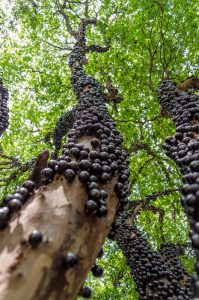 The most surprising aspect of the jabuticaba fruit tree is shown in the picture (and in this video published by Daleys Fruit Tree Nursery): the fruit grows directly on the main trunks. Jabuticabas are one of the most popular fruits in their native Brazil but you probably won’t have tasted them because they are highly perishable and can’t survive the journey to Australia. You can, however, grow them in Australia if you give them some frost protection and they are discussed by Louis Glowinski in this book The Complete Book of Fruit Growing in Australia.
The most surprising aspect of the jabuticaba fruit tree is shown in the picture (and in this video published by Daleys Fruit Tree Nursery): the fruit grows directly on the main trunks. Jabuticabas are one of the most popular fruits in their native Brazil but you probably won’t have tasted them because they are highly perishable and can’t survive the journey to Australia. You can, however, grow them in Australia if you give them some frost protection and they are discussed by Louis Glowinski in this book The Complete Book of Fruit Growing in Australia.
Oobleck
If you follow American politics, you will know that the Dr. Seuss books are rather topical over there at the moment. One such book is Bartholomew and the Oobleck, which follows the adventures of a young boy named Bartholomew Cubbins who must rescue his kingdom from a sticky green substance called ‘oobleck’. Oobleck (named after the book) is actually a real liquid which has the extremely unusual property that it becomes more viscous (i.e. more solid) under pressure.
 Usually a liquid remains a liquid no matter how hard you stir it. By contrast, oobleck temporarily becomes more solid when you stir it. Technically, it is called a ‘shear thickening liquid’. Wikipedia lists only two other substances that behave in this manner, namely silly putty and (bizarrely) chilled caramel ice cream topping. It is effectively the opposite of quicksand, which is normally a solid but which liquefies if, for example, you walk on it.
Usually a liquid remains a liquid no matter how hard you stir it. By contrast, oobleck temporarily becomes more solid when you stir it. Technically, it is called a ‘shear thickening liquid’. Wikipedia lists only two other substances that behave in this manner, namely silly putty and (bizarrely) chilled caramel ice cream topping. It is effectively the opposite of quicksand, which is normally a solid but which liquefies if, for example, you walk on it.
Oobleck is really easy to make at home, comprising just cornflour and water. Simply put some cornflour in a flat-bottomed bowl and slowly add water until the mixture becomes a liquid. It is then easy to feel its weirdness: if you drag your fingers along the top of the liquid, that part which is under your fingers temporarily becomes solid. Here is a relevant video. Something to try out with your grandchildren?
Here is a video of people walking on oobleck. Here is a video of oobleck ‘dancing’ on a speaker cone.
Pineapples
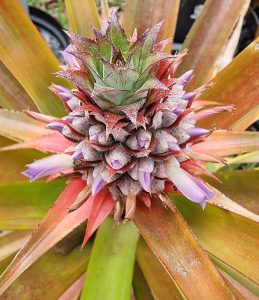 One of the overall points that Louis Glowinski made in his 1997 classic The complete book of fruit growing in Australia is that you can grow just about any fruit tree in Melbourne so long as you look after it appropriately. One of the fruits that I (Guy) have been trying to grow is pineapples, which I grow in pots that I move into the greenhouse during Winter. I grow these pineapples by cutting off and planting the tops of organic, shop-bought pineapples.
One of the overall points that Louis Glowinski made in his 1997 classic The complete book of fruit growing in Australia is that you can grow just about any fruit tree in Melbourne so long as you look after it appropriately. One of the fruits that I (Guy) have been trying to grow is pineapples, which I grow in pots that I move into the greenhouse during Winter. I grow these pineapples by cutting off and planting the tops of organic, shop-bought pineapples.
My pineapple plants sometimes flower. Who would have guessed that pineapple flowers are small, purple and grow out of scales of the incipient pineapple?
Pineapple flowers are apparently usually pollinated by hummingbirds and hummingbirds don’t live in Australia. Luckily, however, pineapples are not technically fruit and apparently grow better when the surrounding flowers have not been pollinated.
Pineapple plants are monocarpic (i.e. they only flower once, then die).
Despite its common name, a pineapple plant is a bromeliad, not a pine nor an apple.
Rocket/arugula
 Many plants, vegetables and fruit have multiple common names, with one name being common in the UK, another in the US, and one or both in Australia. For example, pumpkin(UK)/squash(US), aubergine(UK)/eggplant(US) and swede(UK)/rutabaga(US). One such is rocket(UK)/arugula(US). Interestingly, both ‘rocket’ and ‘arugula’ appear to be derived from the same Latin word ‘eruca’, but by different routes. Rocket: from the Latin eruca through the Northern Italian ruchetta and then the French roquette to the British rocket. Arugula: from the Latin eruca through the Venetian rucola and then the Lombard arigola to the American arugula. It is actually quite common for two words which both sound different and mean different things to have the same root. For example salad/salary (from the Latin ‘sal’ meaning ‘salt’) and mortify/mortgage (from the Latin ‘mors’ meaning death). But are there any examples other than rocket/arugula, where the words come from the same root, sound different but have the same meaning?
Many plants, vegetables and fruit have multiple common names, with one name being common in the UK, another in the US, and one or both in Australia. For example, pumpkin(UK)/squash(US), aubergine(UK)/eggplant(US) and swede(UK)/rutabaga(US). One such is rocket(UK)/arugula(US). Interestingly, both ‘rocket’ and ‘arugula’ appear to be derived from the same Latin word ‘eruca’, but by different routes. Rocket: from the Latin eruca through the Northern Italian ruchetta and then the French roquette to the British rocket. Arugula: from the Latin eruca through the Venetian rucola and then the Lombard arigola to the American arugula. It is actually quite common for two words which both sound different and mean different things to have the same root. For example salad/salary (from the Latin ‘sal’ meaning ‘salt’) and mortify/mortgage (from the Latin ‘mors’ meaning death). But are there any examples other than rocket/arugula, where the words come from the same root, sound different but have the same meaning?
Amazingly, the first recorded usage of the word ‘arugula’ is from the 1960s, only 50 years or so ago. By contrast, rocket has been eaten since Roman times, as evidenced by Virgil’s poem Moretum which includes the line “the rocket excites the sexual desire of drowsy people“.
Soy beans
 Plants whose behaviour depends on day length are called ‘photoperiodic’.
Plants whose behaviour depends on day length are called ‘photoperiodic’.
One way that plants ‘know’ the length of the day (or, more accurately, the length of the night) is because they produce substances (X) in the dark which degenerate to other substances in the light so the night length is proportional to the maximum daily concentration of X. For many plants, day length is at least as important as temperature and this is one reason why so many plants can be grown over so much of the world. This subject is discussed in Chapter 9 of Science and the Garden: The Scientific Basis of Horticultural Practice.
One of the plants that is most sensitive to light is soy beans. Indeed, if there is any street lighting in the vicinity, they apparently consider it to be daylight and often never flower. So, if you live in urban Melbourne, it seems unlikely that you can ever grow soy beans.
To which Heather Elliot responded: For the past few years I have been growing soybeans, latterly of the Edamame kind, and getting a decent crop. Whilst the garden doesn’t receive bright street lighting, it does, until late evening, normally receive some light filtering in from the two townhouses next door.
The taxonomy of citrus
- The 3 progenitors of most of the other citrus species are citron, mandarin and pomelo.
- The standard lemon is (probably) a cross between a citron and a pomelo.
- The sweet orange is (probably) a cross between a mandarin and a pomelo.
- The Meyer lemon is (probably) a cross between a sweet orange and a standard lemon.
- So, the Meyer lemon is a different species than the standard lemon.
- There are at least 14 different species which are called limes, 8+ species which are called lemons and 8+ species which are called oranges.
- I presume that, in general terms, citrus are called lemons when they have yellow fruit, limes when they have greenish fruit and oranges when they have orange fruit (but why, then, tangerines etc?), but I haven’t actually seen anything which says this.
- All 8 of the Australian limes are original species, not crosses.
- The benchmark citrus fruit for marmalade production is the bitter orange, not the sweet orange.
- In tropical regions, with no winter, all citrus fruits remain green thru to maturity. (posted November 4 2015)
The taxonomy of pumpkins
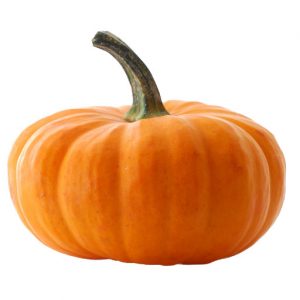 For some plants, the common names closely follow the Latin names. For example, all plants commonly called grevilleas are in the genus Grevillea and most of the plants in the genus Grevillea are called grevilleas in common parlance. For other plants, the relationship between common name and Latin name is more complicated. For example, the common name eucalypt encompasses seven genera (including Corymbia and Angophora as well as Eucalyptus) and plants in the genus Eucalyptus are variously called gums, boxes, mallees, ironbarks, stringybarks, peppermints, mallets, gimlets, etc. Finally, for some other plants, the common name is positively misleading. For example, a native frangipani is not a frangipani (nor closely related to them) and a native fuchsia is not a fuchsia (and an Australian magpie is a butcherbird, not a magpie).
For some plants, the common names closely follow the Latin names. For example, all plants commonly called grevilleas are in the genus Grevillea and most of the plants in the genus Grevillea are called grevilleas in common parlance. For other plants, the relationship between common name and Latin name is more complicated. For example, the common name eucalypt encompasses seven genera (including Corymbia and Angophora as well as Eucalyptus) and plants in the genus Eucalyptus are variously called gums, boxes, mallees, ironbarks, stringybarks, peppermints, mallets, gimlets, etc. Finally, for some other plants, the common name is positively misleading. For example, a native frangipani is not a frangipani (nor closely related to them) and a native fuchsia is not a fuchsia (and an Australian magpie is a butcherbird, not a magpie).
A similar situation applies to edible plants. On the one hand, there is a roughly one-to-one correspondence between plants commonly called mints and plants in the genus Mentha. On the other hand, a cape gooseberry is certainly not a gooseberry and a custard apple is neither a custard nor an apple. And, as I have written about before, most citrus is commonly named by the colour of its fruit rather than by its taxonomic affinity (e.g. 'lemon' and 'meyer lemon' are two of eight species of citrus which have yellow fruit and which are called lemons).
So that brings us (at last!) to pumpkins. In broad terms, the word 'pumpkin' is used to describe varieties of any of the 13 species in the genus Cucurbita where the fruit is a) deemed edible and b) harvested when mature & the skin hardened. Edible varieties which are harvested when immature & the skin is still tender have their own names (e.g. zucchini, tromboncino). Non-edible varieties are called gourds.
If a zucchini is left to mature on the plant then, for some reason, it is called a marrow rather than a pumpkin. And zucchinis are called courgettes in the UK and France.
The word gourd is also used to describe some varieties in both the genus Lagenaria (e.g. bottle gourd) and the genus Luffa (e.g. loofahs) as well as the genus Cucurbita.
Note that the terminology is different in the United States. They use the word 'pumpkin' for those big orange, inedible fruit that they carve coming up to Halloween, the phrase 'winter squash' for what we call pumpkins, and 'summer squash' for zucchinis etc.
Of the 13 species in the genus Cucurbita, only 3 are commonly grown in Australia. The table below lists these 3 species, together with example pumpkin varieties, other edible varieties and some gourd varieties.
| Species | Broad characterisation | Example pumpkin varieties (winter squash) |
Other edible varieties (summer squash) |
Example gourd varieties |
| Cucurbita maxima | The big pumpkins | Jarrahdale Queensland Blue Rouge vif D’Etampes Golden Nugget |
||
| Cucurbita moschata | The standard pumpkins | Butternut Kent/Jap |
Tromboncino | |
| Cucurbita pepo | The other pumpkins | Kumi Kumi | Zucchini/Marrow Spaghetti Squash |
Crown of Thorns Spoon |
Finally, did you notice the reference to 'loofahs' above? Yes, those things that your mother used to scrub your back with in the bath are the dried insides of a type of gourd.
The taxonomy of stonefruit
A few random points:
- Stonefruit refers to the fruit of the prunus genus.
- Unlike citrus, stonefruit species are normal species and don’t naturally hybridise much.
- 7 prunus are commonly eaten: almond, apricot, cherry (2 species), peach and plum (2 species).
- Whilst Sweet Cherries are eaten raw, it is usually a different species – Sour Cherries – that are used in cooking.
- Surprisingly, the European and Japanese plums are different species (with the former being a polyploid and the latter a diploid).
- Nectarines are ‘just’ varieties of peach where the skin is smooth.
- A plumcot is a plum crossed with an apricot. Pluots are 25% apricot and 75% plum. Apriums are 75%
 apricot and 25% plum.
apricot and 25% plum.
But the really interesting species is the almond. The wild almond is both bitter and poisonous (it contains cyanide). So, how come prehistoric humans decided to domesticate it? How did they know that if they spent years breeding the cyanide out of it then it would taste yummy? How many people died before the modern day almond came into being? Was there a series of Cleopatra equivalents who tested poisonous almonds on slaves and some survived and reported back that almonds were potentially edible if only the bitterness were removed?
Witlof/witloof
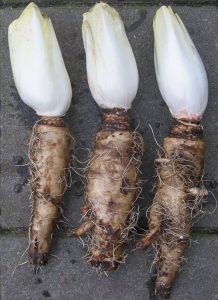
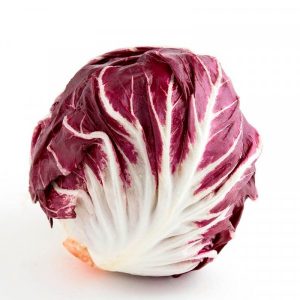 Although they look completely different, witloof and radicchio are actually the same (chicory) plant at different stages in its (artificially managed) life.
Although they look completely different, witloof and radicchio are actually the same (chicory) plant at different stages in its (artificially managed) life.
In the first stage, the plant is grown normally and becomes radicchio or equivalent. The roots (which are parsnip-like) are then dug up and stored for up to a year at 0°C.
In the second stage, the roots are placed into large wooden boxes (without soil, but a bit of nutrient) and kept in the dark. This is a process called hydroponic forcing and results in the witloof.
The process above was accidentally discovered in the 1850s in Belgium and ‘witlof’ is Flemish for ‘white leaf’.

